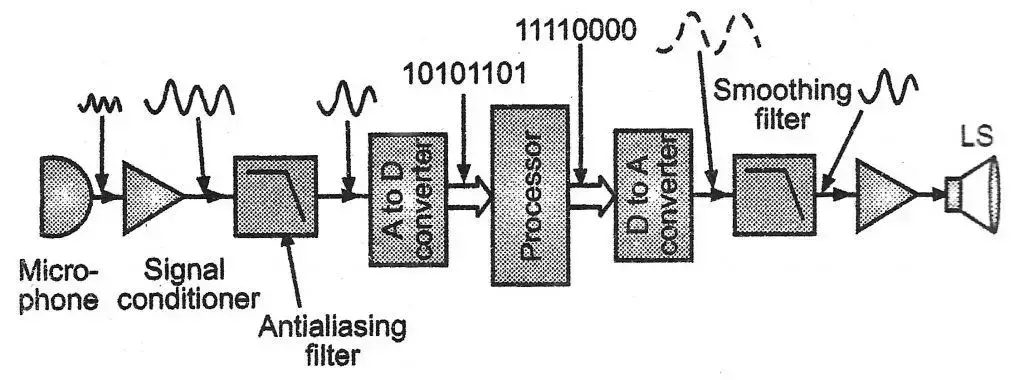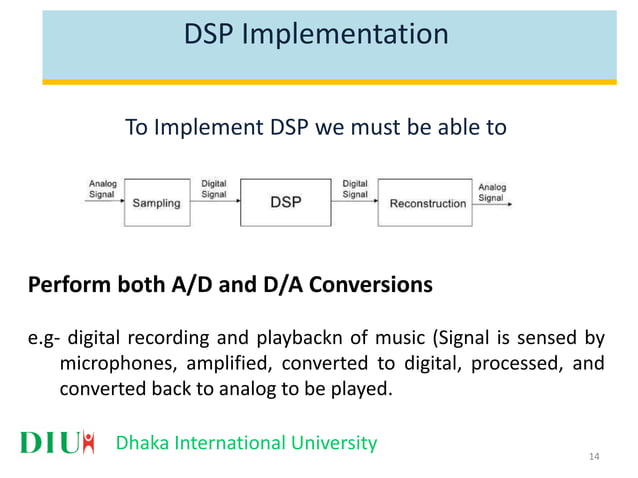Introduction to Digital Signal Processing (DSP) for Programmers

Digital signal processing (DSP) is the mathematical manipulation of a signal, which is a representation of data over time. DSP is used in many applications, including audio processing, image processing, and communications.
 Block Diagram.png)
What is a signal?

A signal is a function that represents data over time. Signals can be analog (continuous) or digital (discrete).
- Analog signals are continuous signals that can take on any value.
- Digital signals are discrete signals that can only take on a finite number of values.
DSP is used to process digital signals. DSP algorithms can be used to perform a variety of operations on signals, including:
- Filtering
- Compression
- Enhancement
Why is DSP important for programmers?
DSP is important for programmers because it provides the tools and techniques needed to process digital signals. DSP algorithms can be used to improve the quality of audio and images, and to develop new and innovative applications.
Getting started with DSP
There are many resources available to help programmers get started with DSP. Some of the most popular resources include:
- Books: There are many books available that provide an introduction to DSP. Some popular books include:
- Digital Signal Processing: A Practical Approach by Emmanuel C. Ifeachor and Barrie W. Jervis
- Digital Signal Processing by Alan V. Oppenheim and Ronald W. Schafer
- Online courses: There are also many online courses available that teach DSP. Some popular courses include:
- DSP for Programmers by Coursera
- DSP Fundamentals by Udacity
- Software: There are many software programs available that can be used to develop DSP applications. Some popular software programs include:
- MATLAB
- Python
- C++
DSP applications
DSP is used in a wide variety of applications, including:
- Audio processing: DSP algorithms can be used to enhance the quality of audio recordings, remove noise, and create special effects.
- Image processing: DSP algorithms can be used to enhance the quality of images, remove noise, and create special effects.
- Communications: DSP algorithms can be used to encode and decode signals, improve the quality of transmissions, and reduce interference.
DSP is a powerful tool that can be used to solve a wide variety of problems. With the right resources, programmers can learn how to use DSP to develop new and innovative applications.## Introduction To Digital Signal Processing (DSP) For Programmers
Executive Summary
Digital signal processing (DSP) is a field of engineering that deals with the processing of discrete-time signals using digital computers. It is a powerful tool that can be used to solve a wide variety of problems in many different disciplines, including audio processing, image processing, and telecommunications.
Introduction
Digital signal processing is a relatively new field, but it has already had a profound impact on many different areas of our lives. For example, DSP is used in the design of digital cameras, cell phones, and MP3 players. It is also used in the development of medical imaging systems, radar systems, and sonar systems.
Top 5 Subtopics
- Time-domain processing
- Deals with signals in the time domain
- Used in applications such as audio processing and speech processing
- Key concepts include sampling, quantization, and filtering
- Frequency-domain processing
- Deals with signals in the frequency domain
- Used in applications such as image processing and spectral analysis
- Key concepts include the Fourier transform and the window function
- Multirate signal processing
- Deals with signals that have different sampling rates
- Used in applications such as digital audio and video processing
- Key concepts include upsampling, downsampling, and interpolation
- Adaptive signal processing
- Deals with signals that change over time
- Used in applications such as noise cancellation and echo cancellation
- Key concepts include the Kalman filter and the least mean squares algorithm
- Statistical signal processing
- Deals with signals that are random in nature
- Used in applications such as speech recognition and image recognition
- Key concepts include probability theory and random processes
Conclusion
DSP is a powerful tool that can be used to solve a wide variety of problems in many different disciplines. It is a rapidly growing field, and it is likely to have an even greater impact on our lives in the years to come.
Keyword Tags
- Digital signal processing
- Time-domain processing
- Frequency-domain processing
- Multirate signal processing
- Adaptive signal processing
FAQ
- What is the difference between analog and digital signals?
- Analog signals are continuous in time and amplitude, while digital signals are discrete in time and amplitude.
- What is sampling?
- Sampling is the process of converting an analog signal into a digital signal.
- What is quantization?
- Quantization is the process of converting a continuous-amplitude digital signal into a discrete-amplitude digital signal.
- What is the Fourier transform?
- The Fourier transform is a mathematical operation that converts a time-domain signal into a frequency-domain signal.
- What is the Kalman filter?
- The Kalman filter is a recursive algorithm that can be used to estimate the state of a dynamic system.
